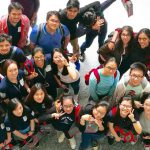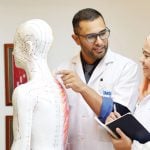Since Antonie van Leeuwenhoek discovered bacteria using a self-invented simple single lens microscope, the use of microscope has opened up a new era in the world of science. Microscopes are used to view tiny objects that are too small to been seen clearly or cannot been seen at all by human naked eyes. Nowadays, microscopes play important roles in life sciences from the study of microorganisms, the structure of cells, to the crystalline structures of molecules. 
Due to the importance of microscope in life sciences, especially in the field of biotechnology where new discoveries for disease control and management are anticipated from time to time, IMU Medical Biotechnology students (MB117) were given the opportunity to participate in a microscope workshop conducted by Abu Farris, a product specialist from Matrix Optics (M) Sdn Bhd. The objectives of the workshop are to provide an introduction to different types of microscopes and their applications in research, as well as good practice in microscope handling.
The workshop began with an ice breaking session, followed by a talk on various component of a light microscope. The facilitator also introduced the different types of microscopes that are used in research such as confocal, phase contrast, fluorescence, differential interference contrast microscope, and the guidelines in selecting microscope for different specimen viewing. For example, brightfield microscopy are commonly used in the field of haematology, cytology, anatomy, histology, pathology and genetics for stained specimen, while darkfield microscopy is preferred in dermatology and gynaecology. Unstained samples are commonly viewed by contrast methods such as darkfield, phase contrast, differential interference contrast or relief contrast. Besides, he also highlighted some common mistakes in handling microscope, and demonstrated the correct ways to use a microscope as well as its maintenance. Most microscope users are not aware of the function of eyepiece diopter which is the eye sight corrector to compensate for a perfect vision based on individual eye sight. He also introduced the use of eyepiece rubber eye-guard of which functions as an eyeshade to eliminate stray light from interfering with observation when it is unfolded from its original positions. The talk was followed by a hands-on session where the students were given the chance to apply what they had learnt and practice their skills in microscopy, before the workshop was ended with Q&A session.
| What Students Say About the Workshop |
|---|
| This workshop helped to improve our understanding on the importance of correct handling of microscope. We learnt several techniques that can help in extending the lifespan of the microscope. – Cathy Lo |
| The workshop was very helpful because we were able to learn many new techniques which we did not learn before, during our lab sessions. This helped us to improve our skills in using microscope to observe the specimens. – Monisyhaa Vijayan |
| The workshop was quite fun as the moderator was good and friendly. – Melvin Teoh |
| The workshop was very informative and provided a glimpse into the different techniques that can be used to analyse specimens based on users’ requirements. The trainer also shared the proper ways to care and maintain microscopes. – Chan Chin Chun |










